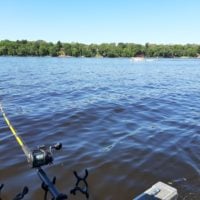There are two PDF files attached, one for each type of lead.
My gift to you IDO.
When using this chart in current you need to estimate the current speed.
When going into current, add the current speed to the GPS speed.
When going with current, subtract the current speed from the GPS speed.
The chart will show you the depth of the leadcore line only.
How to use the chart example: Using the 7′ dive curve chart: I’m going 3MPH into a current strength of 1MPH, therefore i’m going 4 MPH. I want my leadcore to dive to a depth of 20′. I let out 171′ of leadcore line. My lure will dive a few feet lower, depending on the leader and lure. At 4 mph each foot of depth requires 8.57′ of leadcore line.
This chart does not include the depth created from your leader length and your crankbait. Those vary depending on crank, braid or mono, and of what size.
You can get your lure in the water with only the leader out and estimate the depth the crank is running.
Example, crank & leader dive 4′. If you want your crank running at 24′, then set your leadcore line to the 20′ depth and your lure will run 20’+4’=24′.
Few Additions:
Calibrate your line counter reels. Personally i calibrate mine to 100′.(Simple google search)
This is important when running suspended baits over deep water. Also important when you are running more than 1 rod. Having a calibrated reel also means that you can trust your depth chart. When you are confident in your depth chart, and you let out your line anticipating ticking the bottom…But find you have to let out more – you likely have an out of tune crank.
TUNE YOUR CRANKS (another simple google search, and very very important!)
Leadcore/Leader connection: I tie my leader to my leadcore by tying an overhand knot in the leadcore and snipping off the tag end, then i use a uni knot to attach the leader to the leadcore above the overhand knot. Very simple and strong. I prefer braid unless water conditions require otherwise. I typically keep my leaders under 15′ in length.
A good tip is to learn how to back calculate. Example (Using 7′ curve): I am going 3 mph GPS. I don’t know the current strength. I do know it is 15′ deep. I do know my leader and lure dive 3′ on their own account. I’ll let out line until i hit bottom. My line counter is 120′ when i hit bottom….First, subtract your leader/lure dive from the depth of water (15′ – 3′ = 12′) This means my leadcore is running at 12′ depth. On the left side of chart i find 12′. Then I look horizontally until i find 120′ of line, then i look at the MPH above and the chart shows 4.5 or 4.75 MPH. Therefore i’m running 3 mph GPS speed into a current of 1.5 to 1.75 mph.
Now, when you want to change depths – you know which speed column your in.
You can also dead drift to estimate current speed..i.e. if it isn’t windy float downstream and monitor GPS speed.
Enjoy your lead lining!
